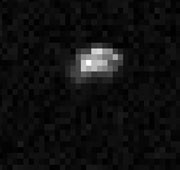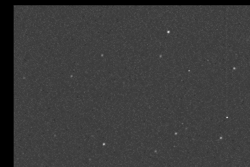Astronomy:(612901) 2004 XP14
 2004 XP14 imaged by the Goldstone Solar System Radar in 2006 | |
| Discovery | |
|---|---|
| Discovered by | LINEAR |
| Discovery date | 10 December 2004 |
| Designations | |
| Minor planet category | NEO · Apollo · PHA |
| Orbital characteristics[1] | |
| Epoch 13 January 2016 (JD 2457400.5) | |
| Uncertainty parameter 0 | |
| Observation arc | 1007 days (2.76 yr) |
| |{{{apsis}}}|helion}} | 1.21822 astronomical unit|AU (182.243 Gm) |
| |{{{apsis}}}|helion}} | 0.884900 AU (132.3792 Gm) |
| 1.05156 AU (157.311 Gm) | |
| Eccentricity | 0.158488 |
| Orbital period | 1.08 yr (393.87 d) |
| Mean anomaly | 10.1555° |
| Mean motion | 0° 54m 50.45s /day |
| Inclination | 32.9505° |
| Longitude of ascending node | 281.045° |
| 273.695° | |
| Earth MOID | 0.00316799 AU (473,925 km) |
| Physical characteristics | |
| Mean diameter | 260 m[2] 300–800 m[3] |
| Rotation period | 100 h (4.2 d)[1] |
| Absolute magnitude (H) | 19.4[1] |
(612901) 2004 XP14 is a sub-kilometer asteroid, classified as a near-Earth object and potentially hazardous asteroid of the Apollo group. It was first observed by the LINEAR project on 10 December 2004.
Description
Although initially there were concerns that it might possibly impact Earth later in the 21st century and thus merit special monitoring, further analysis of its orbit has since ruled out any such collision, at least in the foreseeable future.
The size of 2004 XP14 is not precisely known. Based on optical measurements, the object is between 300 and 800 meters in diameter.[1] Radar observations place a lower bound of about 260 meters (850 ft).[2]
2004 XP14's closest pass by Earth was above the west coast of North America at 04:25 UTC on 3 July 2006.[1]
The asteroid's distance from Earth's center of mass at that moment was 0.0028906 astronomical unit|AU (432,430 km; 268,700 mi),[1] or just 1.1 times the Moon's average distance from Earth. It was observed immediately after this close approach by radar from three locations, from Goldstone in the Mojave Desert in the US, from Sicily, and from Yevpatoria RT-70 radio telescope, Ukraine , as well as optically from other observatories[4] and amateurs.
It was removed from the Sentry Risk Table on 17 March 2005.[5]
| Asteroid | Date | Nominal approach distance (LD) | Min. distance (LD) | Max. distance (LD) | Absolute magnitude (H) | Size (meters) |
|---|---|---|---|---|---|---|
| (152680) 1998 KJ9 | 1914-12-31 | 0.606 | 0.604 | 0.608 | 19.4 | 279–900 |
| (458732) 2011 MD5 | 1918-09-17 | 0.911 | 0.909 | 0.913 | 17.9 | 556–1795 |
| (163132) 2002 CU11 | 1925-08-30 | 0.903 | 0.901 | 0.905 | 18.5 | 443–477 |
| 69230 Hermes | 1937-10-30 | 1.926 | 1.926 | 1.927 | 17.5 | 668–2158 |
| 69230 Hermes | 1942-04-26 | 1.651 | 1.651 | 1.651 | 17.5 | 668–2158 |
| (27002) 1998 DV9 | 1975-01-31 | 1.762 | 1.761 | 1.762 | 18.1 | 507–1637 |
| 2002 NY40 | 2002-08-18 | 1.371 | 1.371 | 1.371 | 19.0 | 335–1082 |
| 2004 XP14 | 2006-07-03 | 1.125 | 1.125 | 1.125 | 19.3 | 292–942 |
| 2015 TB145 | 2015-10-31 | 1.266 | 1.266 | 1.266 | 20.0 | 211–682 |
| (137108) 1999 AN10 | 2027-08-07 | 1.014 | 1.010 | 1.019 | 17.9 | 556–1793 |
| (153814) 2001 WN5 | 2028-06-26 | 0.647 | 0.647 | 0.647 | 18.2 | 921–943 |
| 99942 Apophis | 2029-04-13 | 0.0981 | 0.0963 | 0.1000 | 19.7 | 310–340 |
| 2017 MB1 | 2072-07-26 | 1.216 | 1.215 | 2.759 | 18.8 | 367–1186 |
| 2011 SM68 | 2072-10-17 | 1.875 | 1.865 | 1.886 | 19.6 | 254–820 |
| (163132) 2002 CU11 | 2080-08-31 | 1.655 | 1.654 | 1.656 | 18.5 | 443–477 |
| (416801) 1998 MZ | 2116-11-26 | 1.068 | 1.068 | 1.069 | 19.2 | 305–986 |
| (153201) 2000 WO107 | 2140-12-01 | 0.634 | 0.631 | 0.637 | 19.3 | 427–593 |
| (276033) 2002 AJ129 | 2172-02-08 | 1.783 | 1.775 | 1.792 | 18.7 | 385–1242 |
| (290772) 2005 VC | 2198-05-05 | 1.951 | 1.791 | 2.134 | 17.6 | 638–2061 |
References
- ↑ 1.0 1.1 1.2 1.3 1.4 1.5 "JPL Close-Approach Data: (2004 XP14)". http://ssd.jpl.nasa.gov/sbdb.cgi?sstr=2004XP14;cad=1#cad. Retrieved 30 March 2016.
- ↑ 2.0 2.1 Benner, Lance A.; Ostro; Giorgini; Busch; Rose; Jao; Jurgens (2006). "Radar Observations Of Asteroid 2004 XP14: An Outlier In The Near-earth Population". American Astronomical Society 38 (2): 621. Bibcode: 2006DPS....38.6807B.
- ↑ "Absolute Magnitude (H)". NASA/JPL. http://neo.jpl.nasa.gov/glossary/h.html. Retrieved 2011-09-27.
- ↑ Ledford, Heidi (2006). "Asteroid fly-by eludes study". Nature 442 (7105): 855. doi:10.1038/442855a. PMID 16929265. Bibcode: 2006Natur.442..855L.
- ↑ "Date/Time Removed". NASA/JPL Near-Earth Object Program Office. http://neo.jpl.nasa.gov/risk/removed.html. Retrieved 2012-03-19.
External links
- NASA's Asteroid Radar Group
- Asteroid may pose danger to Earth
- Close pass by space rock
- Sormano Astronomical Observatory: Minor Body Priority List
- Minimum Orbital Intersection Distance
- Closest Approaches to the Earth by Minor Planets
- (612901) 2004 XP14 at NeoDyS-2, Near Earth Objects—Dynamic Site
- Ephemeris · Obs prediction · Orbital info · MOID · Proper elements · Obs info · Close · Physical info · NEOCC
- (612901) 2004 XP14 at ESA–space situational awareness
- (612901) 2004 XP14 at the JPL Small-Body Database
 |


